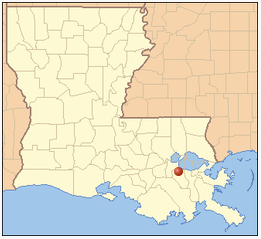| Home | Search | Emissions | Pollutants | About the Database |

Valero (26003), Norco
LDEQ Accident Report
| Accident # | 155645 |
| State Police # | 14-01902 |
| Accident Date | 2014-04-30 |
| Report Date | 2014-05-07 |
| Follow-up Date | 2014-06-27 |
| Follow-up: | Yes |
Pollutants Released
| Pollutant | Duration | Point Source | Greenhouse Gas | Criteria Pollutant | Ozone forming chemical | Amount of Release |
| Carbon Monoxide | 4h 30m | Flares 1, 2, 3 | NO | YES | NO | 510.8 pounds |
| NOx | 4h 30m | Flares 1, 2, 3 | NO | NO | YES | 93.9 pounds |
| Particulate Matter | 4h 30 m | Flare 1 | NO | YES | NO | 3.3 pounds |
| Volatile Organic Compounds (VOCs) | 4h 30m | Flares 1, 2, 3 | NO | NO | YES | 1,229.9 pounds |
| Hexane | 4h 30m | Flares 1, 2, 3 | NO | NO | NO | 11.9 pounds |
| Sulfur Dioxide | Flares 1, 2, 3 | NO | YES | NO | 1,645.2 | |
| Hydrogen Sulfide | Flares 1, 2, 3 | NO | NO | NO | 8.8 pounds | |
| Carbon Monoxide | Flares 1, 2, 3 | NO | YES | NO |
Accident Classified As: Reportable Quantity
Cause of Problem: Power Failure
The fluid cat cracking unit (FCCU) wet gas compressor shut down due to a loss of power that resulted from a transformer short circuit and a circuit breaker malfunction. As a result, flaring occurred from permitted flares 1, 2 and 3. Workers reduced total feed and reactor temperature in the FCCU to minimize flaring until compressors could be restarted. Transformer failed in the EP-03A substation. A relay setting associated with this system was not set properly and allowed the fault current to reach the Good Hope Substation. The fault was cleared by the breaker at the Good Hope Substation. As a result, several other transformers also tripped and upset the FCCU. This accident exceeded maximum hourly permitted emissions for sulfur dioxide, hydrogen sulfide, hexane, and Volatile Organic Compounds at Flare 1 for one hour. Maximum hourly permitted emissions were also exceeded for NOx and carbon monoxide at Flare 2 for one hour. Maximum hourly permitted emissions for sulfur dioxide and Volatile Organic Compounds at Flare 2 for 5 hours. Reportable quantities for sulfur dioxide and propylene were exceeded.
Discharge Preventable - No
Not "reasonably preventable." The relay setting was established by a qualified third party electrical engineering company and is not a system typically reviewed internally by Valero. However, the refinery is modifying its review practices to include relay settings to prevent recurrence.
Notes/Remedial Actions
At the time of the accident, emissions were minimized by reducing the overall rate to the unit and reactor temperature. Operators responded by adjusting the power distribution system in order to reestablish the poewr source and restart the compressors. Throughout the event, the Flare Gas Recovery Unit remained in operation to reduce the amount of flared gas. Process changes have been implemented as corrective actions. These include: - updated relay settings - refinery arch flash study and relay setting review - even distribution of four P82-808 pumps across the electrical feed buses - modify MOC checklist to include relay settings and coordination curves - modify PSSR checklist to include relay settings and coordination curves - require all new or changed relay setting requested through CSE with relay setting/coordination curve request form - communicate incident to affected personnel - communicate incident and path forward to CSE electrical engineers, MP electrical engineers and maintenance electrical supervision

Connect With Us: